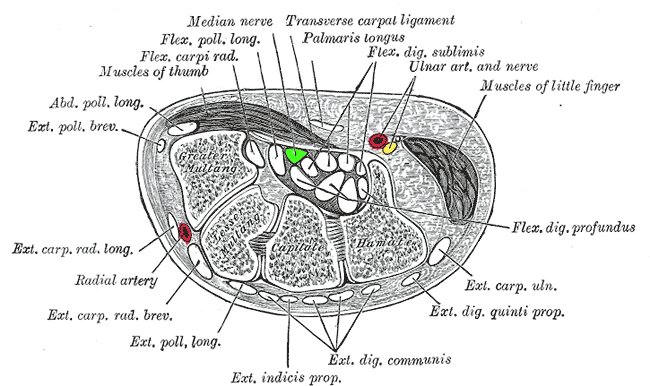Carpal
Tunnel Syndrome
 What is Carpal
Tunnel Syndrome?
What is Carpal
Tunnel Syndrome?
Carpal Tunnel Syndrome is a condition
which usually arises due to repeated pressure on the carpal
tunnel. This often results in pinching the median
nerve (pictured at right in green)
in the wrist. The carpal tunnel is a bony hollow within the
underside of the wrist in which the median nerve is located. Pinching or compression of this nerve by
the transverse carpal ligament (a tendon in
the hand) can lead to a progressively crippling
disorder.
What are the
Symptoms of Carpal Tunnel Syndrome?
Common symptoms include
wrist pain, numbness and tingling in the hand, pain
consisting of a 'pins and needles' feeling at night,
weakness in grip and a general reduction in dexterity and
lack of precision in movement.
What Causes Carpal Tunnel Syndrome to
Develop?
Typically Carpal Tunnel Syndrome arises from
performing forceful repetitive actions with the hands and
wrists such as typing, writing or even grasping
objects. This condition occurs more often in women
than men, due to smaller bone structures in the wrist which
make the hollow thinner. It
can arise when the muscles used to perform these activities
become inflamed, compressing the tunnel. It can also
occur by exerting pressure directly on the soft underside of
the wrist (in between the bottom of the palm and the
underside of the forearm). This pressure can come from
the edge of a desk (if the work surface is higher than the
elbows of the user) or even a raised 'support' such as a
wrist 'rest' which in many cases causes more problems than
it solves.
What Movements Should be Avoided if you
have Carpal
Tunnel Syndrome?
Prevent any direct pressure and indirect
pressure (from inflammation) in the wrist, and maximize blood
flow. Avoid putting pressure on the unprotected
underside of the wrist. Avoid twisting at the wrist
(from left to right). To visualize this, a theoretical
line drawn from the elbow, through the forearm and extended
forward should go through the middle finger on the hand when
avoiding positions of Ulnar
Deviation or radial deviation. Avoid bending the
wrist up (Wrist
Extension) or down (wrist flexion) too much past a
neutral relaxed position. Ensure good blood flow to the
wrist through the arm by avoiding movements or postures in the
arm or upper body which constrict blood flow.
What Types of Products can be Used to
Help Prevent or Reduce the Symptoms and Incidence of Carpal Tunnel Syndrome?
Separated
Keyboards and Fixed
Split Keyboards can help to prevent lateral twisting
at the wrist when keyboarding, and Compact
Keyboards (i.e. those without a numeric keypad) will
prevent twisting at the wrist when reaching for the
mouse. Orthopedic
Mice of the correct size for the user which properly
support the structure of the hand in a neutral posture help
to prevent compression of the carpal tunnel. Articulating
Keyboard Arms can assist by ensuring that the work
surface is at the correct height.

 What is Carpal
Tunnel Syndrome?
What is Carpal
Tunnel Syndrome?